Not forgotten: A Belgian soldier remembered in Kent
On 6 February 2025, a small ceremony took place in the churchyard of St Mary the Virgin, in Westerham, Kent, in which a determined band met to pay respects at the 'lost' grave of Private R.A. Thioux, a Belgian soldier of the First World War.
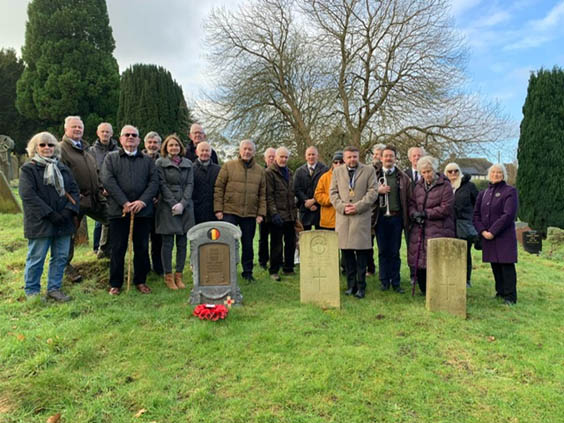
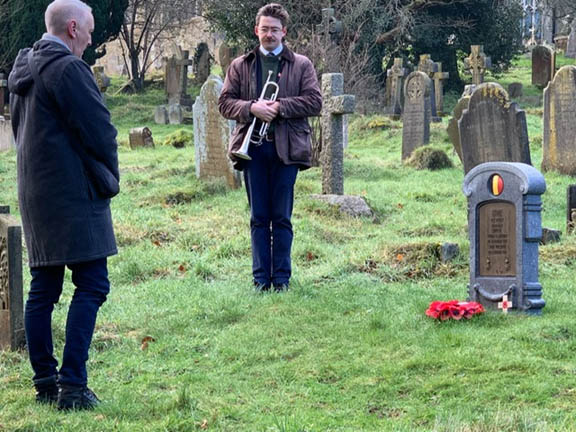
Ewan Carmichael takes up the story:
I retired from the Regular Army in 2015 and was lucky to be able to attend a battlefield tour of Belgium, with the International Guild of Battlefield Guides, facilitated by Philippe Maree and his excellent Belgian Wallonian tourist organisation.
Shortly after my return, I visited this churchyard and there was, at that time, a standing display in the church relating to the effects of the First World War in the parish. I had long known about the grave of Soldat Sterckx, and had begun laying a marker there every armistice. However, hidden within the display in the church, the records showed that there was a second Belgian.
That piqued my interest, and I began a hunt, but couldn't find anything. So I asked the parish office and initially learned that Private Thioux had been buried within the churchyard. It was thought that he had died after the end of the war in 1920, and that was the reason for him having no official headstone. However, the great news was that the location of his plot had been carefully recorded, so I could find the precise site of his grave. Every year since 2015 I have been leaving a tribute to Private Thioux in November, just to prove that .... as I used to write it, he was 'Not Forgotten'.
I was in communication with several Belgian historians who helped me in my researches, and it transpired that Private Thioux had actually died on 1 November, so before the end of the war.
Further communication with Mr Steve Maertens, of the Belgian War Graves Service confirmed that Private Thioux was entitled to an official war grave headstone. Steve came over in the Summer of 2022, along with a colleague from the Commonwealth War Graves Commission.
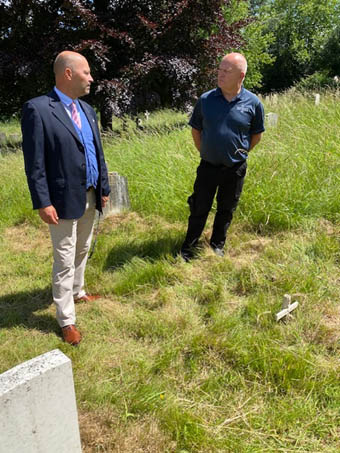
How did we have situation in which one soldier was publicly remembered, while the other was unmarked? The initial grave markers were wooden, and it is possible that one rotted faster than the other. When the Belgian authorities toured to begin a programme of replacing wooden crosses with headstones, it is possible that Private Thioux had already been lost.
So, together Steve and I applied to the parish and to the Diocese for permission to have this work carried out. I am grateful to the Commonwealth War Graves Commission for collecting the headstone, for bringing it to England, and then for installing it.
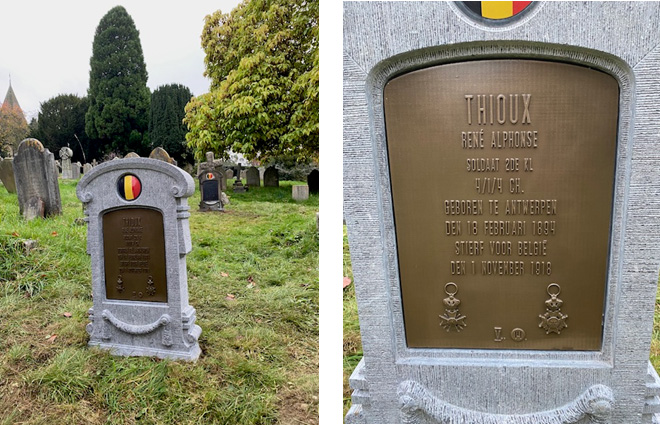
I now turn to give a short account of how two Belgians come to be buried here.
I am confident that this audience knows that enough about the First World War to understand that Imperial rivalries had led to an international arms race. A series of alliances had created essentially two main groupings, balanced very precariously...on a hairspring, as it were. The assassination of Archduke Franz Ferdinand of Austria-Hungary in Sarajevo on 28 June 1914, caused a series of declarations of war, invoked by alliance commitments. In essence, Austria-Hungary and Germany looked both East and West against Serbia, Russia, France and Britain, and her Empire. As part of that system, Germany was committed to fighting against Russia, France and Britain. Assuming that Russia would take some time to mobilise, Germany elected to strike rapidly against France in a plan named after its originator, General Schlieffen. This involved the bulk of the Germany Army swinging through Belgium on 4 August in order to get to France and encircle Paris. At that time, Belgium was neutral. The invasion of Belgium led to many atrocities and correspondingly much anger in the British press. Britain declared war against the Central Powers on 4 August.
Belgium defended herself gallantly, but the contest was uneven, with a German Army of 750,000 pitted against 220,000 Belgian defenders. Many wounded Belgians were evacuated all the way to England, some 54 being taken in to a Voluntary Aid Detachment (VAD) Hospital at Dunsdale House to convalesce. (Dunsdale House is on the Brasted Road). At a time when antibiotics were only in their infancy, it is unsurprising that a proportion of wounded combatants died of complications.
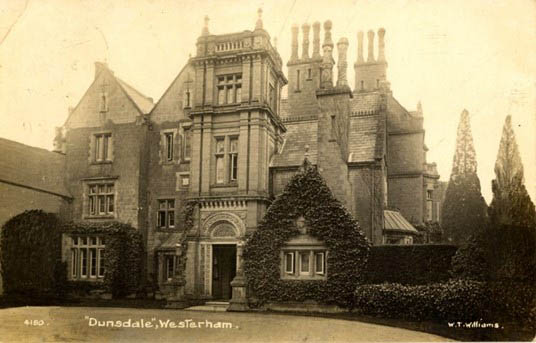
Soldat Sterckx died on 16 October 1914. He was buried on 23 October, in a large ceremony, marked by a strong civic turnout and with bands playing.
Private René Alphonse Thioux, who we particularly commemorated at the ceremony in February, was born in Antwerp on 18 February 1894. He had lost a foot. At some point during his time in England, he met a lady, by the name of Cowlard, whom he married at Hampstead in 1915. They lived with a Mrs Wood, at 3 Railway Terrace, Westerham. When he died of Tuberculosis on 1 November 1918, he left his widow, but also a child: Alphonse Achille Thioux, who was born only two months before his father's death. The birth was registered in St Ives, Cambridgeshire. The son married one Daphne Martin in 1940.
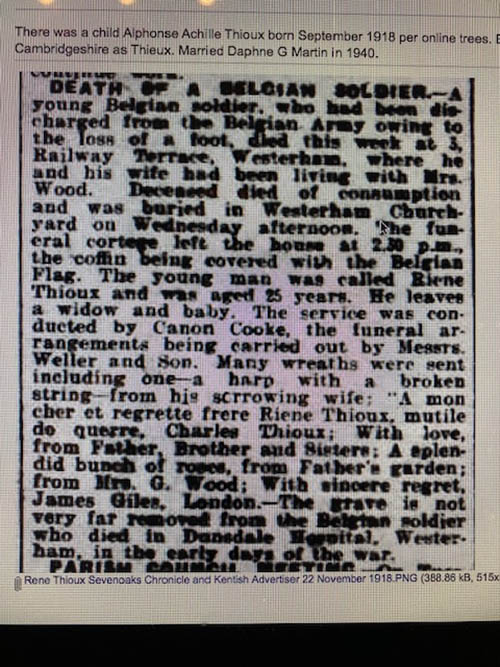
Private Thioux's death and burial were reported in the Sevenoaks Chronical of 22 November 1918, and it was reported that his widow had laid a wreath in the shape of a harp with a broken string.
It would have been lovely if we could have had a descendent of the Thiouxs today, but efforts to trace them by the Commonwealth War Graves Commission have been fruitless.
Much of what follows is taken from the website sevenoaksww1.org.
It may also be of interest to note that Sevenoaks took in many Belgian refugees, and one man in particular is commemorated in the churchyard of St Nicholas. There is an inscription on the family grave of the Caplen family:
Also in loving memory of my dear husband, Sergeant Emile Leonard de Coster, 22nd Infantry Belgium Army, killed about 9th June 1919, somewhere in Germany aged 35 years
No one knows how I miss him
No one knows how he died
No one knows how he suffered
No one knows where he lies
Sgt Emile de Coster was one a several wounded Belgians being treated in Sevenoaks Voluntary Aid Detachment 56, at St John's Hospital, Holly Bush Lane, Sevenoaks. Sgt de Coster had married this lady while recovering in England, but he had returned to the continent, and the Army of Occupation of Germany. At Rheinberg, near Cologne, he had drowned in a swimming accident. His widow campaigned to have him exhumed and brought to England, or failing that, Belgium. Ultimately, her campaign was partly successful as he was reburied in Belsele.
In 1914, the Sevenoaks Chronicle highlighted how local people were engaged in raising money and collecting clothes for the refugees already in their midst. On 23 October, the Chronicle reported a whist drive being held in the Weald for the destitute Belgians Fund, while Mr Frank Robinson let it be known that the cinema was admitting Belgian refugees and soldiers in to the mid-week and Saturday matinee for free.
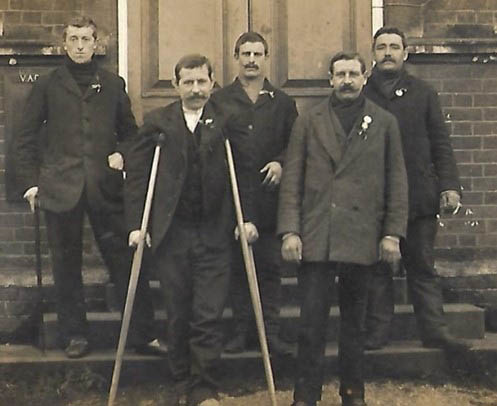
The Chairman of the Urban District Council, appealed for more means to deal with the “present and future needs of the Belgian Refugees in Sevenoaks”. He noted that:
Were it not for the brave resistance of the countrymen of these exiles France would probably now be completely over-run by the common enemy and the prospects of the Allies very different to what they are to-day. Try to imagine what we would feel, if, like these people, we were fugitives with no means of livelihood for the future. We cannot exploit the sorrows of our guests. They are here in our midst, representative of every class, members of the aristocracy, tradesmen, artisans and country people. All alike in having lost everything.
One young Belgian soldier had not seen his brother since the commencement of the war and he feared that he was dead, wounded or missing, but discovered that he was also in Sevenoaks and was able to be rejoin him.
In general, the Belgian refugees received a friendly and supportive welcome in Sevenoaks. One report from a local soldier highlighted that this relationship worked both ways. Percy Ellman had written:
My battery was gassed and we lost temporarily a 47 gun. I got lost after the ‘scrap’ for two days but I found a real good Belgian Samaritan, who gave me rest and food and told me he was only returning the kindness shown to Belgian refugees in England.
In closing, it might be fitting to quote the great Turkish statesman Kemal Ataturk who, in 1934, addressed a delegation from his former enemies at Gallipoli:
Those heroes that shed their blood and lost their lives are now lying in the soil of a friendly country. Therefore, rest in peace. There is no difference between the Johnnies and the Mehmets to us where they lie side by side here in this country of ours. You, the mothers, who sent their sons from far away countries, wipe away your tears. Your sons are now lying in our bosom and are in peace. After having lost their lives on this land, they have become our sons as well.
Becoming a member of The Western Front Association (WFA) offers a wealth of resources and opportunities for those passionate about the history of the First World War. Here's just three of the benefits we offer:
This magazine provides updates on WW1 related news, WFA activities and events.
Access online tours of significant WWI sites, providing immense learning experience.
Listen to over 300 episodes of the "Mentioned in Dispatches" podcast.





